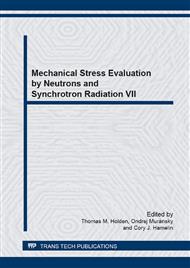p.124
p.130
p.136
p.142
p.148
p.155
p.161
p.165
p.171
Temperature Induced Internal Stress in Carrara Marble
Abstract:
Stone physical weathering, deterioration and damage (e.g. bowing, cracking, microfracturing) represent a serious problem for preservation of sculptural and architectural heritage objects. Although different mechanisms of such degradation might be responsible (e.g. chemical or biogenic), there is an understanding in the geological community that physical reasons for stone degradation and role of stress are of primary importance. In this work Carrara marble was a chosen for investigation: a calcitic type with ~20% of dolomite. Neutron diffraction was used to investigate the phase composition, the texture, and the strain/stress in calcite and dolomite phases in a bulk marble sample. Evolution of the stress state was studied by measuring strains in calcite and dolomite at two temperatures with clear evidence of thermally induced microstresses. Results are discussed in connection to the theory of composite materials and a micro-mechanical explanation of the general problem of marble deterioration is suggested.
Info:
Periodical:
Pages:
148-154
Citation:
Online since:
February 2014
Authors:
Keywords:
Price:
Сopyright:
© 2014 Trans Tech Publications Ltd. All Rights Reserved
Share:
Citation:


